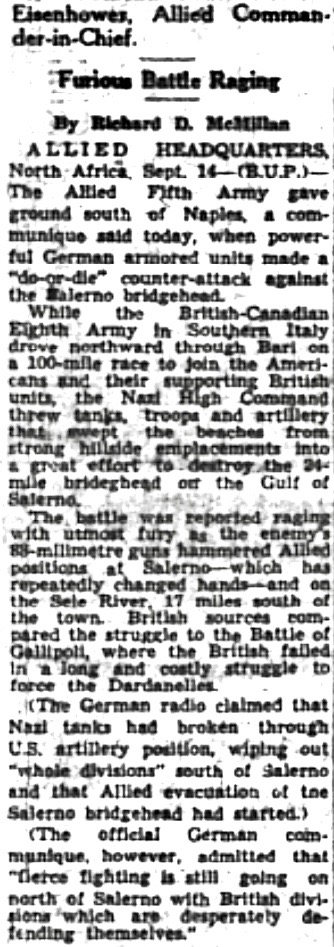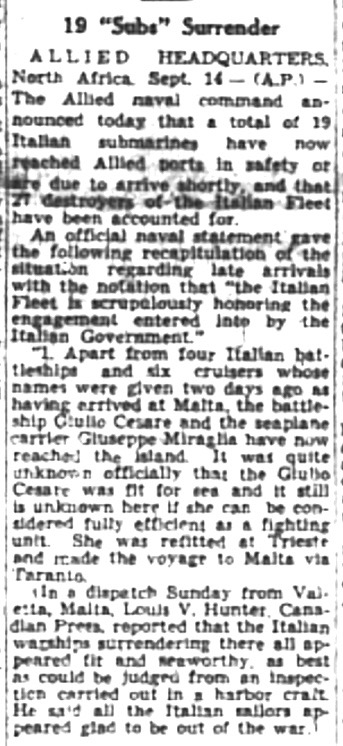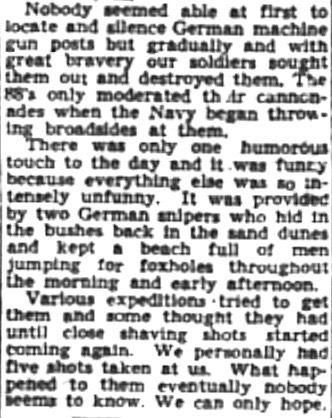Allied Progress Slowed at Salerno by Stiff Defences
The Montreal Star, on microfilm at University of Western Ontario
I continue to look through September issues of The Montreal Star hoping to solve a double mystery: Who is the reporter from The Star who hitched a ride with the Canadians in Combined Ops who were operating a flotilla of landing crafts between Messina (Sicily) and Reggio di Calabria (Italy's toe) in September, 1943? Could it be Sholto Watt or Ross Munro? And did either of them (or some other writer/reporter) post stories that mentioned members of the Canadian flotilla, including my father?
Maybe it's a triple mystery: And where's Sholto? I have seen one story he wrote, early on in the Italian campaign, but not a word since.
As I share a few of the items from The Star we will see some of the slow, grinding progress made my Allied forces under the command of Monty (British 8th Army) and Clark (U.S. 5th Army). It was a tough slog and - spoiler alert - they did not enter Rome until June 5, 1944, one day before D-Day Normandy.
More timely news, photographs and cartoons, etc., to give readers a bit of the flavour of the times:
Clayton Marks of London, Ontario, shares information about the intensity of the desperate battle at Salerno in this following excerpt from a book he assembled and distributed (chiefly to veterans of RCNVR and Combined Operations) in the early 1990s:
On shore, the race, as usual was between our own build-up and the arrival of German reinforcements. The critical period began on the evening of the 13th, the fifth day of the fighting. The British were in Salerno town, though the heights above it were in dispute.
Maybe it's a triple mystery: And where's Sholto? I have seen one story he wrote, early on in the Italian campaign, but not a word since.
As I share a few of the items from The Star we will see some of the slow, grinding progress made my Allied forces under the command of Monty (British 8th Army) and Clark (U.S. 5th Army). It was a tough slog and - spoiler alert - they did not enter Rome until June 5, 1944, one day before D-Day Normandy.
More timely news, photographs and cartoons, etc., to give readers a bit of the flavour of the times:
Clayton Marks of London, Ontario, shares information about the intensity of the desperate battle at Salerno in this following excerpt from a book he assembled and distributed (chiefly to veterans of RCNVR and Combined Operations) in the early 1990s:
On shore, the race, as usual was between our own build-up and the arrival of German reinforcements. The critical period began on the evening of the 13th, the fifth day of the fighting. The British were in Salerno town, though the heights above it were in dispute.
On the other side of the Gulf the Americans were in Agropoli. The deepest penetration on any part of the front was five miles, and it averaged less than four. Mark Clark's Headquarters had been established ashore for 36 hours.
The Germans had been building up near Eboli, on the edge of the hills north of the Sele River; and that evening with the best part of four divisions and a large number of Tiger tanks, they drove a wedge between the British and the American forces, bursting out on to the plain and getting perilously close to the sea. Their guns were shelling the beaches and their aircraft bombing them. The closer they pressed, the more difficult became our own troop movements in an area which was getting more and more constricted.
Once again, Naval bombardment was called into play, and quantities of shells were fired while the Allied Air Force made the most concentrated attacks that had ever been made in a battle area in one day.
Once again, Naval bombardment was called into play, and quantities of shells were fired while the Allied Air Force made the most concentrated attacks that had ever been made in a battle area in one day.
The German War Diary states that the heavy ships' bombardment and the almost complete command of the fighting area by the far superior enemy air force, had cost us grievous losses. By the 16th, the Eighth Army was drawing near from the south, and its leading patrols making contact with the Americans. The German bolt was shot and the Salerno battle saved, but as a measure of how nearly the German counter-strike succeeded, Clark's Headquarters had had to re-embark, and preliminary orders had been issued for the abandonment of some of the southern beaches.
It is pleasant to record that the three Winettes - Boxer, Thruster and Bruiser - played a notable part in this operation. They made six separate trips between the beaches and bases ports in Sicily and Tunisia, and could have made more if they had not, on one voyage, been kept waiting about for 40 hours unloaded. They put 1345 guns and vehicles and 6000 officers and men ashore into the beachhead at a time when they were badly needed. The same applied to many officers and ratings on the LCT's and the LST's who were deeply and severely involved in the landings.
So ended Salerno, a hard and difficult battle, the severest test so far of the technique of Combined Operations.
Page 104 - 105 - Combined Operations by Clayton Marks, London ONT.
More details about the Italian conflict follow from The Montreal Star:
All of the photographs found on microfilm accompanying reports in The Star are of poor quality. That being said, occasionally I can locate a better copy of the photo. At the very least, we know the photograph exists and determined microfiche and Google sleuths may be able to locate associated articles and photos.
Young Canadian sailors in RCNVR joined Combined Ops as early as December, 1941 and arrived in the UK in January, 1942 to begin training aboard landing crafts, e.g., at HMS Northney (on Hayling Island, opposite Havant, south coast of England), HMS Quebec (just south of Inveraray, Scotland), and Camp Auchengate (south of Irvine, Scotland and adjacent to RAF Dundonald). Below is mention of the first class of fresh-faced midshipmen from Royal Roads, BC.:
Other Canadians fill the role of recording the action! Better copies of this photograph may still exist just south of my home city!
(Might there be a Stollery family in St. Thomas? The answer is 'yes.' I have found three phone numbers. To be continued.)
We read in Combined Operations by C. marks of London that "The critical period began on the evening of the 13th, the fifth day of the fighting."
Here we read about the tight spot that the U.S. 5th Army encountered:
Miss Harrison of Toronto - and other A.T.A. 'girls' - had terrific adventures!
The headline in the Sept. 15 issue is a positive one for the Allied Forces:
About the three mysteries I am trying to solve via my research. I have wondered if Ross Munro is the war correspondent I am looking for during this wander through The Montreal Star. He did in fact accompany Canadian sailors in landing crafts and his articles do appear in The Star.
Did the writer of the report that motivated my search just get a slight detail wrong? Hopefully I will know by the time I reach the October 7 issue!
It is pleasant to record that the three Winettes - Boxer, Thruster and Bruiser - played a notable part in this operation. They made six separate trips between the beaches and bases ports in Sicily and Tunisia, and could have made more if they had not, on one voyage, been kept waiting about for 40 hours unloaded. They put 1345 guns and vehicles and 6000 officers and men ashore into the beachhead at a time when they were badly needed. The same applied to many officers and ratings on the LCT's and the LST's who were deeply and severely involved in the landings.
So ended Salerno, a hard and difficult battle, the severest test so far of the technique of Combined Operations.
Page 104 - 105 - Combined Operations by Clayton Marks, London ONT.
More details about the Italian conflict follow from The Montreal Star:
All of the photographs found on microfilm accompanying reports in The Star are of poor quality. That being said, occasionally I can locate a better copy of the photo. At the very least, we know the photograph exists and determined microfiche and Google sleuths may be able to locate associated articles and photos.
Young Canadian sailors in RCNVR joined Combined Ops as early as December, 1941 and arrived in the UK in January, 1942 to begin training aboard landing crafts, e.g., at HMS Northney (on Hayling Island, opposite Havant, south coast of England), HMS Quebec (just south of Inveraray, Scotland), and Camp Auchengate (south of Irvine, Scotland and adjacent to RAF Dundonald). Below is mention of the first class of fresh-faced midshipmen from Royal Roads, BC.:
Other Canadians fill the role of recording the action! Better copies of this photograph may still exist just south of my home city!
(Might there be a Stollery family in St. Thomas? The answer is 'yes.' I have found three phone numbers. To be continued.)
We read in Combined Operations by C. marks of London that "The critical period began on the evening of the 13th, the fifth day of the fighting."
Here we read about the tight spot that the U.S. 5th Army encountered:
Miss Harrison of Toronto - and other A.T.A. 'girls' - had terrific adventures!
The headline in the Sept. 15 issue is a positive one for the Allied Forces:
About the three mysteries I am trying to solve via my research. I have wondered if Ross Munro is the war correspondent I am looking for during this wander through The Montreal Star. He did in fact accompany Canadian sailors in landing crafts and his articles do appear in The Star.
Did the writer of the report that motivated my search just get a slight detail wrong? Hopefully I will know by the time I reach the October 7 issue!
The "prairie cyclone" is now called "tiger."
More articles from The Montreal Star will follow.
Unattributed Photos GH











































No comments:
Post a Comment